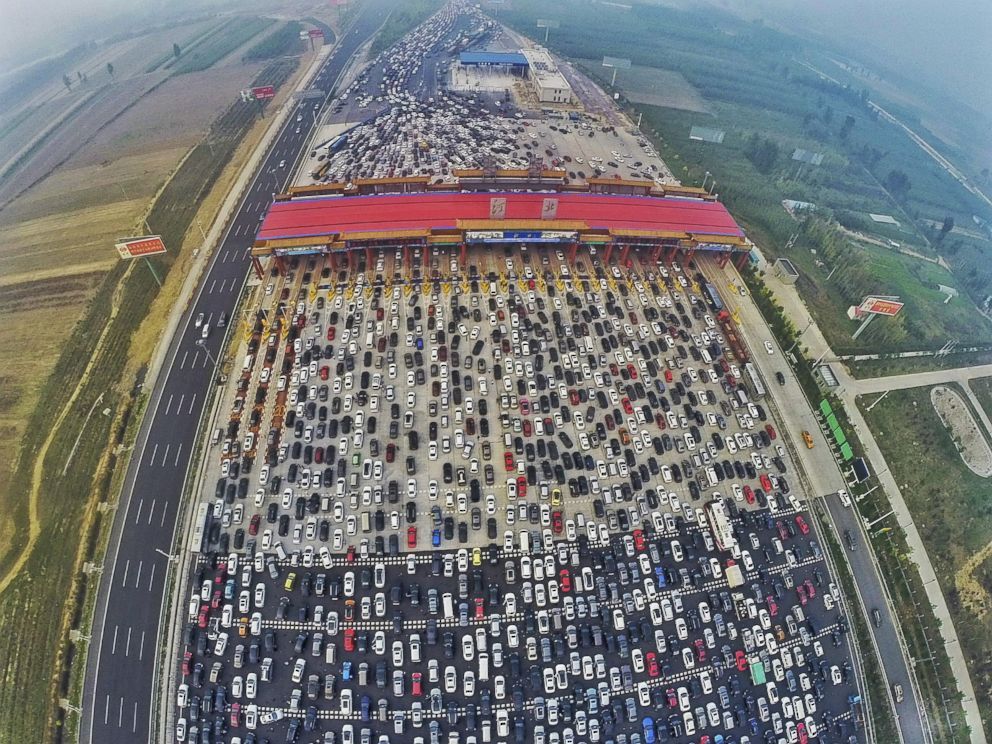The Wrong Peak, Part 2: Technological Change

by JACK HAYNIE, ’20
The oil industry, like any other sector of the economy, is eternally at the mercy of technological change. Increasingly, petroleum has been pressured by changes to industries where it once was the unquestioned energy source of choice. Even where it is still used, innovations in fuel efficiency have drastically reduced the raw volume of oil needed to accomplish basic tasks, putting further downward pressure on demand.
In no area is this more pronounced than transportation. Over the past 15 years, oil’s role in personal transportation has become markedly less secure. This transformation has been led by a singularly important, yet also unassuming, trend: the recent and unbroken rise in fuel efficiency. This trend has been most marked in Europe and the United States, where the implementation of fuel efficiency measures since 2005 has reduced fuel consumption by the equivalent of the total amount of oil used for transportation in Italy in 2014.[1] In the United States and Europe, efficiency increases have played a key role in flattening oil demand, with efficiency gains offsetting increased vehicle usage in the United States, leveling off oil consumption projections through 2040.[2]
Outside the developed world, where car size and usage has increased at a much faster rate, fuel efficiency in developing markets saw a smaller, but still marked, increase. Many large economies, such as China[3] and India, [4] have either implemented carbon emissions standards like those already in place in the OECD or have strengthened existing regulations. Importantly, China has implemented especially strict measures, placing them ahead of all major economies except Japan and the European Union in efficiency regulations.
Over the course of the past 35 years, the average internal combustion engine has become 20% more efficient, and new fuel saving technologies slated for wide implementation across the auto industry are expected to increase efficiency by a further 40% by 2035.[5] The pace of this takeoff in energy efficiency is highlighted by a study conducted by the Stanford Department of Resource Engineering and Department of Environmental Science. This study surveyed the global rate of fuel efficiency improvements and transportation usage patterns over the past forty years and notes that simply continuing current rates of fuel efficiency improvement would be sufficient to create peak oil demand by mid-century, absent other technological innovations and new policy initiatives.[6]
While increased fuel efficiency has played the most significant role in driving technologically-based decline in oil demand, other, more visibly disruptive technology systems have the potential to make as large an impact. While not as impactful as advertised by industry boosters, electric vehicles do have some potential to compound the declining demand growth set in motion by the rise in global fuel efficiency. Previously dogged by higher costs compared to oil burning vehicles and reliant on public subsidies to remain competitive, electrical vehicles now have the potential to become viable alternatives for many consumers. Prices of battery packs, once the main constraint on electrical vehicles’ commercial viability, have collapsed over the past 6 years,[7] a trend which will only strengthen with time.[8] Simultaneously, other hurdles to mass electric vehicle adoption have been mitigated, as automakers have increased the range of electric vehicles by 20-40%,[9] and a combination of public and private investors announced plans to drastically scale up investment in investment in charging infrastructure for electric vehicles by $5.5 billion dollars over the next twenty years.[10]
This spate of disruptions in the electrical vehicle industry has had almost immediate results. Once relegated to niche markets, electric vehicle sales in the European Union, the United States, and China have increased by 160%. Over the long-term, this trend stands to become even more pronounced, as costs decline and high-density urban populations, which have traditionally been more amenable to purchasing cleaner but lower range electric vehicles, come to dominate the consumer base of many third world nations.[11] By 2030, at current industry-predicted growth rates, electric vehicles will represent 50% of new vehicles sold in the three markets mentioned above, [12] notably dominating the vehicle mix in China, the world’s largest auto market, where they are projected to account for 70% of new vehicles.[13]
These changes in the composition of the personal transportation sector will have a significant effect on oil consumption as electric vehicles grow from less than 1% to 6% of the global vehicle fleet over the next thirty years.[14] This increase, which amounts to 100 million vehicles worldwide, will have a profound impact on the energy sector, as single-user cars account for a fifth of global energy demand. This spread of electric vehicles alone will not have a revolutionary impact on petroleum demand; the ensuing reduction in oil use will only amount to 10% of the demand reduction of efficiency increases. It does, however, illustrate the extent to which petroleum’s former near-monopoly on personal transport has eroded as technology has progressed, and exacerbates the downward pressure on oil demand already driven by improvements in fuel efficiency. When considered alongside efficiency gains, the increasing market share of electric vehicles could lower oil demand growth by a substantial amount, approximately 18.2 million barrels per day by 2035.[15]
While technological changes in transportation dominate many discussions about the future of oil (unsurprising given the transportation sector’s massive share of global oil demand) other changes have also played a role in reversing the upward momentum of petroleum demand. While many sectors, such as electricity generation, have moved away from oil, few have experienced as much disruption as the petrochemical industry. Seemingly safe from many of the deep disruptions affecting the personal transport industry and demonstrating a robust projected demand growth of around 1.4% per year out to 2050 (60% of the total demand growth for oil),[16] petrochemicals would seem to be a future driver of demand growth for the oil industry. However, much like its role in personal transportation, petroleum’s place as the singularly most important petrochemical feedstock is under threat.
Like efficiency standards have helped to stretch each barrel of oil further for personal transportation, new recycling techniques and improved packaging efficiency have significantly lowered the relative quantity of oil required to feed demand for petrochemical products. Given these drastic shifts, the old rule of thumb that plastics demand would grow at 1.3 to 1.4 times GDP has given way to a new normal of demand growth closer to 1.2 times GDP. This situation is will only become pronounced, as current recycling rates are projected to improve from 8% today to 20% in 2035 as the amount of plastic packaging used globally is likely to decline by 5%.[17] This implies a reduction in oil demand of approximately 2.5 million barrels a day.
At the same time, the falling prices and rising abundance of natural gas has made natural gas-derived ethane a lower-cost competitor to petroleum, allowing producers to create an equivalent amount of product at one third the cost.[18] This realignment of the petrochemical industry is almost as profound as similar changes impacting personal transportation. The spread of recycling technologies could cost the oil industry 6 million barrels per day of demand growth over the next twenty years.
This piece is part of a four-part series. The third and fourth parts are coming soon.
Works Cited
[1] Bandivadekar, Anup, Joshua Miller, Drew Kodjak, Rachel Muncrief, Zifei Yang, Rob De Jong, Bert Fabian, Lew Fulton, Stephen Perkins, Jari Kauppila, Pierpaolo Cazzola, and Richard Clarke. “Fuel Economy State of the World 2016.” Fuel Economy State of the World. Accessed August 12, 2017.
[2] US Energy Information Administration. “Annual Energy Outlook 2017 with Projections to 2050.” US EIA Annual Energy Outlook 40, no. 1 (January 5, 2017).
[3] Oliver, Hongyang, Kelly Sims Gallagher, Dongliang Tian, and Jinhua Zhang. “China’s Fuel Economy Standards for Passenger Vehicles: Rationale, Policy Process, and Impacts.” Harvard Kennedy School Energy Technology Innovation Policy Project 1, no. 1 (March 2009). Accessed August 11, 2017.
[4] Nagar, Vrinda. “Government Proposes Implementation Rules First Ever Fuel Consumption Norms Passenger Cars.” The Center for Science and Environment. February 9, 2017. Accessed September 1, 2017.
[5] Roelofsen, Occo, Namit Sharma, Rembrandt Sutorius, and Christer Tryggestad. “Is Peak Oil Demand in Sight?” McKinsey & Company. Accessed September 07, 2018.
[6] Brandt, Adam, Adam Millard-Ball, Matthew Ganser, and Stephen Gorelick. “Peak Oil Demand: The Role of Fuel Efficiency and Alternative Fuels in a Global Oil Production Decline.” Environmental Science & Technology 47, no. 14 (May 2013): 8031-041.
[7] Knupfer, Stefan, Russell Hensley, Patrick Hertzke, Patrick Schaufuss, Nicholas Laverty, and Nicolaas Kramer. “Electrifying Insights: How Automakers Can Drive Electrified Vehicle Sales and Profitability.” McKinsey Advanced Insights- Advanced Industries, January 2017.
[8] Newman, Mark. “ELECTRIC REVOLUTION: INVESTING IN THE CAR OF THE FUTURE.” Bernstein Global View 50 (March 10, 2017).
[9] Knupfer, Stefan, Russell Hensley, Patrick Hertzke, Patrick Schaufuss, Nicholas Laverty, and Nicolaas Kramer. “Electrifying Insights: How Automakers Can Drive Electrified Vehicle Sales and Profitability.” McKinsey Advanced Insights- Advanced Industries, January 2017.
[10] Newman, Mark. “ELECTRIC REVOLUTION: INVESTING IN THE CAR OF THE FUTURE.” Bernstein Global View 50 (March 10, 2017).
[11] “Niche for Electric Vehicles in Developing Countries.” Niche for Electric Vehicles in Developing Countries | Stanford Energy Journal. March 09, 2016. Accessed August 07, 2017. https://sej.stanford.edu/niche-electric-vehicles-developing-countries.
[12] Roelofsen, Occo, Namit Sharma, Rembrandt Sutorius, and Christer Tryggestad. “Is Peak Oil Demand in Sight?” McKinsey & Company. Accessed September 07, 2018.
[13] Zhang, Qian, Xunmin Ou, Xiaoyu Yan, and Xiliang Zhang. “Electric Vehicle Market Penetration and Impacts on Energy Consumption and CO2 Emission in the Future: Beijing Case.” Energies 10, no. 228 (February 15, 2017).
[14] British Petroleum. “BP Statistical Review of World Energy June 2017.” BP Statistical Review of World Energy 66 (June 2017). Accessed May 20, 2018.
[15] Ibid
[16] Jaffe, Amy Myers. “Big Oil Is Betting on Plastics. It May Be a Risky Bet.” The Wall Street Journal. July 21, 2017. Accessed September 07, 2018.
[17] Roelofsen, Occo, Namit Sharma, Rembrandt Sutorius, and Christer Tryggestad. “Is Peak Oil Demand in Sight?” McKinsey & Company. Accessed September 07, 2018.
[18] Sherman, Lilli Manolis. “Natural Gas Boom: What Will It Mean for Plastics Processors?” Plastics Technology. October 24, 2013. Accessed September 07, 2018.





